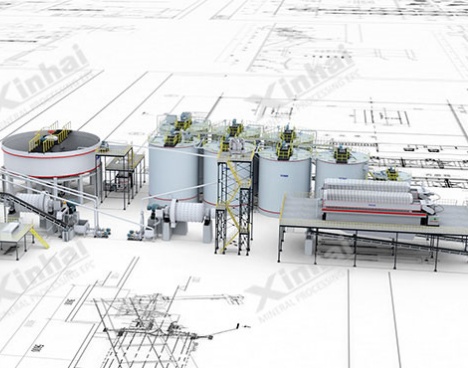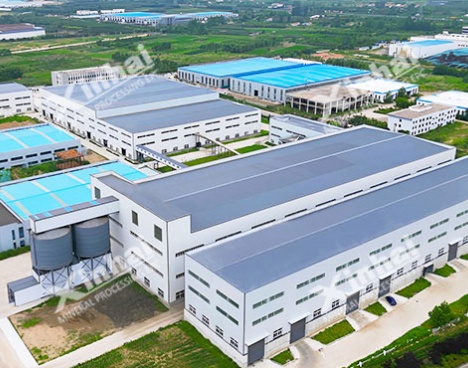Amid the intensifying fluctuations in global iron ore prices, the design optimization of beneficiation plants has become a key factor in determining a company’s competitiveness. This article analyzes how systematic design can reduce the processing cost per ton of ore by 10%–20%, based on cutting-edge process practices and equipment selection data, making it particularly suitable for the development of low-grade iron ores with TFe content between 25%-35%.
Through the "crushing-screening-dry separation" integrated workshop design, conveyor belt transport length is reduced by 40% (Typical case: A certain iron ore mine in Shandong reduced 3 transfer stations, saving 1.27 million RMB annually on electricity)
BIM technology is used to simulate material flow, achieving a vertical height connection between the crushing system and grinding-separation workshops, thus reducing the energy consumption of secondary material lifting
A 5°-8° natural slope is used to achieve self-flowing slurry, reducing energy consumption by 32% compared to a fully-pumped system (measured data from a beneficiation plant in Yunnan)
Innovative design of stepped thickening pools utilizes topographical elevation differences to form a gravity dewatering system

High-pressure grinding roll (HFKG-180 model) combined with two-stage closed-circuit crushing keeps the grinding particle size stable at -8mm or below
Comparison test data: Compared to traditional three-stage crushing, the ball mill power consumption is reduced by 1.8 kWh/t
Dry magnetic separation after coarse crushing (CTDG-1510 model) can discard 18%-25% of waste rock
Wet pre-selection process (magnetic separator + spiral chute combination) increases the ore grade by 5–8 percentage points
Two-stage grinding + three-phase separation system: The first stage uses the MQG5585 ball mill (capacity 320t/h) for coarse grinding and tailings discard, and the second stage uses vertical mills for fine grinding
The washing magnetic separator (CXJ-80 series) keeps the concentrate grade stable at above 66.5%
The HP800 cone crusher has a crushing ratio of 6.5:1, and the product pass rate is increased to 92% with PLC automatic adjustment of the discharge opening
The PF-1820 impact crusher achieves 80% of the product with a particle size of -15mm
The Φ5.5×8.5m large ball mill reduces unit processing costs by 28% compared to the Φ3.6m equipment
The hydrocyclone group (FX840-GT6) achieves classification efficiency of over 85%
Full-magnetic system magnetic separators (CTB-1232) with a background field strength of 0.8T reduce tailings grade by 0.7 percentage points
A combined flotation column and mechanical flotation cell process reduces reagent consumption by 15%

The dry discharge system (deep cone thickener + plate-frame filter press) achieves tailings moisture content of<18%, meeting the requirements for construction aggregate production
Backfilling mining technology application case: A certain iron mine in Hebei saved 5.6 million RMB annually in tailings disposal costs
The plant's front water recycling system (inclined-tube sedimentation + super-magnetic separation) reduces new water consumption to 0.15m³/t
Rainwater collection pool design has a capacity for 3 days' worth of water usage to cope with extreme weather and ensure production continuity
Real-time monitoring of over 2000 process parameters, with mill load fluctuations controlled within ±3%
The intelligent dosing system (X-ray fluorescence analyzer + fuzzy control) achieves reagent usage precision of ±2%
Vibration analyzer + infrared thermal imaging provide early warning of equipment failures 48 hours in advance
The digital twin model simulates the effect of process adjustments, reducing trial-and-error costs by 70%
The energy-saving rate of slurry pump variable frequency transformation reaches 25%-40%
Application of permanent magnet motors in magnetic separator drive systems saves 180,000 kWh annually
Ball mill cylinder waste heat (80-120°C) is used for ore pre-drying, reducing dryer energy consumption by 30%
Waste heat recovery from air compressors supplies the bathing system, saving 450,000 RMB annually in coal expenses
Economic Verification: Comparison Data from a 500,000-ton/year Beneficiation Plant
| Indicator | Traditional Scheme | Optimized Scheme | Reduction |
|---|---|---|---|
| Power consumption per ton of ore | 32.7 kWh | 26.4 kWh | 19.3% |
| Steel cost | 8.6 RMB | 6.3 RMB | 26.7% |
| Labor cost | 4.2 RMB | 2.8 RMB | 33.3% |
| Payback period | - | 2.8 years | - |
Conclusion
Through the system integration of six major technical modules, modern iron ore beneficiation plants have successfully transformed from "extensive production" to "precise control." Practice shows that by adopting optimized designs, the total cost of concentrate for newly-built plants can be controlled within the range of 180–260 RMB per ton, providing a feasible technical path for the development of low-grade iron ores. With the deep application of intelligent control technologies, the industry is expected to usher in a new round of cost reduction and efficiency improvement breakthroughs within the next 3–5 years.